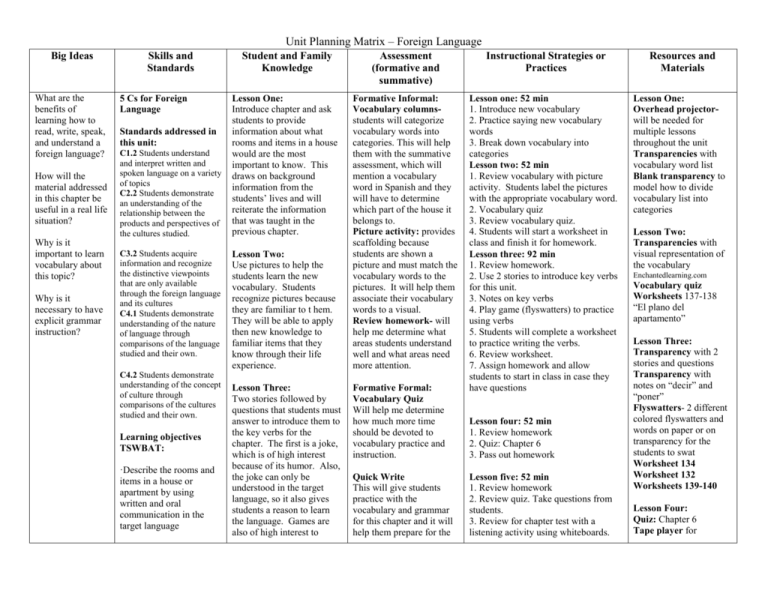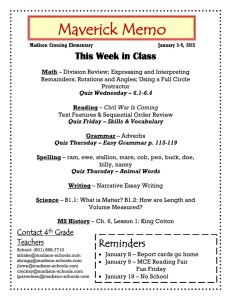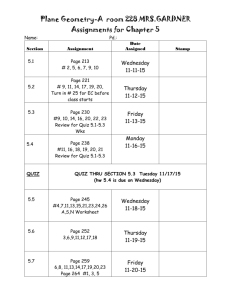Unit Planning Matrix – Foreign Language Exemplar
advertisement

Unit Planning Matrix – Foreign Language Big Ideas What are the benefits of learning how to read, write, speak, and understand a foreign language? How will the material addressed in this chapter be useful in a real life situation? Why is it important to learn vocabulary about this topic? Why is it necessary to have explicit grammar instruction? Skills and Standards 5 Cs for Foreign Language Standards addressed in this unit: C1.2 Students understand and interpret written and spoken language on a variety of topics C2.2 Students demonstrate an understanding of the relationship between the products and perspectives of the cultures studied. C3.2 Students acquire information and recognize the distinctive viewpoints that are only available through the foreign language and its cultures C4.1 Students demonstrate understanding of the nature of language through comparisons of the language studied and their own. C4.2 Students demonstrate understanding of the concept of culture through comparisons of the cultures studied and their own. Learning objectives TSWBAT: ·Describe the rooms and items in a house or apartment by using written and oral communication in the target language Student and Family Knowledge Assessment (formative and summative) Instructional Strategies or Practices Lesson One: Introduce chapter and ask students to provide information about what rooms and items in a house would are the most important to know. This draws on background information from the students’ lives and will reiterate the information that was taught in the previous chapter. Formative Informal: Vocabulary columnsstudents will categorize vocabulary words into categories. This will help them with the summative assessment, which will mention a vocabulary word in Spanish and they will have to determine which part of the house it belongs to. Picture activity: provides scaffolding because students are shown a picture and must match the vocabulary words to the pictures. It will help them associate their vocabulary words to a visual. Review homework- will help me determine what areas students understand well and what areas need more attention. Lesson one: 52 min 1. Introduce new vocabulary 2. Practice saying new vocabulary words 3. Break down vocabulary into categories Lesson two: 52 min 1. Review vocabulary with picture activity. Students label the pictures with the appropriate vocabulary word. 2. Vocabulary quiz 3. Review vocabulary quiz. 4. Students will start a worksheet in class and finish it for homework. Lesson three: 92 min 1. Review homework. 2. Use 2 stories to introduce key verbs for this unit. 3. Notes on key verbs 4. Play game (flyswatters) to practice using verbs 5. Students will complete a worksheet to practice writing the verbs. 6. Review worksheet. 7. Assign homework and allow students to start in class in case they have questions Lesson Two: Use pictures to help the students learn the new vocabulary. Students recognize pictures because they are familiar to t hem. They will be able to apply then new knowledge to familiar items that they know through their life experience. Lesson Three: Two stories followed by questions that students must answer to introduce them to the key verbs for the chapter. The first is a joke, which is of high interest because of its humor. Also, the joke can only be understood in the target language, so it also gives students a reason to learn the language. Games are also of high interest to Formative Formal: Vocabulary Quiz Will help me determine how much more time should be devoted to vocabulary practice and instruction. Quick Write This will give students practice with the vocabulary and grammar for this chapter and it will help them prepare for the Lesson four: 52 min 1. Review homework 2. Quiz: Chapter 6 3. Pass out homework Lesson five: 52 min 1. Review homework 2. Review quiz. Take questions from students. 3. Review for chapter test with a listening activity using whiteboards. Resources and Materials Lesson One: Overhead projectorwill be needed for multiple lessons throughout the unit Transparencies with vocabulary word list Blank transparency to model how to divide vocabulary list into categories Lesson Two: Transparencies with visual representation of the vocabulary Enchantedlearning.com Vocabulary quiz Worksheets 137-138 “El plano del apartamento” Lesson Three: Transparency with 2 stories and questions Transparency with notes on “decir” and “poner” Flyswatters- 2 different colored flyswatters and words on paper or on transparency for the students to swat Worksheet 134 Worksheet 132 Worksheets 139-140 Lesson Four: Quiz: Chapter 6 Tape player for Unit Planning Matrix – Foreign Language ·Identify the present and preterite forms of the irregular verbs “decir” and “poner” ·Comprehend basic reading material (such as advertisements and newspaper listings) with information related to homes, apartments, and home furnishing students because it allows them to be hands on with the language and it gives them a chance to receive high praise for their participation in the game. Lesson Four: Solicit answers from students to review homework. Lesson Five: Using the whiteboards allow is an interactive way of reviewing the information. It sustains their interest because it requires their attention and it can become a game where they race each other to see who can answer first. upcoming test’s writing portion. Chapter Quiz Will help me determine what areas need more attention in the review lesson before the Chapter Test. It will have the same format as the chapter test. Summative: Chapter Test Will assess students on the skills and objectives for this lesson. It will have a listening comprehension section, writing and grammar section, and reading comprehension. Students review vocabulary and verbs by listening to the questions and writing down the answers on the whiteboards. Lesson six: 92 min 1. Take Chapter 6 Test 2. Review test. 3. Begin new unit listening section Audio Cassette Lesson Five: Transparency of quiz Tape player and audio cassette Whiteboards- 1 per student Dry erase marker- 1 per student Tissue or paper towel for eraser Lesson Six: Chapter 6 Test Tape player Audio cassette Additional resources: Ya Verás, Nivel 2 Textbook and Testing program www.enchantedlearnin g.com Unit Planning Matrix – Foreign Language Rationale and explanation The criteria specified by Wiggins serve to develop essential questions that determine the main ideas for a unit. The essential questions that I developed for this unit can be applied to all of the units I teach, but the explanation that is given for every unit in response to those questions is what will differ. One of the reasons this problem arises in foreign language is because the content standards are not explicit. There are not any explicit standards that are specific for every level of a Spanish language classroom. The 5 Cs (communication, cultures, comparisons, connections, and communities) are general and broad standards, which makes perfect sense because every language has its own structure. The standards are always taken into consideration and addressed in lesson planning. One must always find a way to incorporate several aspects of the 5Cs when planning listening, speaking, writing, or reading activities. However, the 5Cs do not explicitly dictate the direction of the curriculum. Therefore, it is a departmental decision as to what objectives will be attained in every level of Spanish and how those objectives will be taught throughout the course of the school year. In this unit students will come away with skills that will further develop their ability to read, write, speak, and listen in the target language. This unit is actually the last chapter of a unit called “Vamos a instalaranos” (Let’s get settled in) and the theme for this particular chapter is called “Buscamos un apartamento” (We are looking for an apartment). It is important for students in a foreign language classroom to learn new vocabulary, grammar, and cultural concepts in a theme because it contextualizes the information. Therefore, it is comprehensible to the students and easier to memorize. The chapter revolves around vocabulary words of items in a home, but these can be linked to situations other than the home. For example, eating utensils are covered in the chapter, but the ability to name eating utensils in the target language can Unit Planning Matrix – Foreign Language transfer to situations other than the home, like eating at a restaurant. Therefore, we make a lot of connections to other information learned. However, the answers for the essential questions should come from the students. I let them come up with examples that express how this chapter will be useful to them. I use the essential question: How will the material addressed be useful in a real life situation? I pose this question to students at the beginning of every chapter. Students’ answers vary, but the question is posed to give meaning and relevance to the lesson. I also provide students with my reasons that show how the information they will learn will be useful in real life situations. Reasons such as study abroad purposes, living abroad, visiting relatives or friends in Spanish speaking country, and jobs are reasons why it is important to learn the information from this chapter. Aside from the themed vocabulary, grammar instruction must also be included. This can seem repetitive because we have been covering the preterite tense since November. However, it is important to reiterate the information to students for various reasons. The first is that repetition and practice helps students remember the rules for conjugation. Key verbs are also a good way of scaffolding grammar instruction because it gives them practice with particular verbs, then conjugation skills can be applied to other verbs. Grammar instruction in general is very important to every lesson because it teaches students how the language works. Once they know the basics, students will be able to apply the skills in more complex situations. The grammar instruction is also tied to the theme to help students link the information together. Again, this all ties back to the standards because those 5Cs are guidelines that show how the information should be tied together, but not what should be taught. However, the reasons previously stated show why this chapter is included as part of the curriculum for level two Unit Planning Matrix – Foreign Language Spanish. It is a chapter with valuable information that will increase students’ vocabulary and grammar skills. CIAS Links As previously noted, linking the information learned in previous chapters is essential in a Spanish class. However, presenting the material in an engaging manner is also extremely important in order to keep a high student interest level. This chapter ties together the concept of the CIAS because all of the components are taken into consideration when lesson planning. The curriculum takes students into consideration and that is why the information is presented using contextualized activities. The curriculum also requires students to continue building with new information learned, but it also constantly draws from student’s prior knowledge. In this chapter, from the very first lesson students are asked to provide information from their life experience. This information then transfers to the vocabulary that students are presented with. Then, students are presented with a variety of activities that will appeal to different learning styles. However, before those activities are planned the assessment tools must be examined. Every worksheet, quiz, test and any other assessment tool that may be used should be examined before planning the lesson. It is important to look at these in advance and plan backwards. This helps teach a lot of valuable material, but also highlights what information needs emphasis. After this has been done, then the activities can be planned that will support students in learning the material. It is important to choose a variety of activities to appeal to different students to sustain students’ interest in the material. Notes and lectures are given, but kept short. They are necessary to give explanation of the material. Then, other activities are presented, such as games, which allow students to use the language in a fun and engaging way. The games provide practice with the language, but also help develop their listening and speaking skills. Worksheets Unit Planning Matrix – Foreign Language are also given in order to prepare students for the reading and writing portion of their quiz and test. The exercises in the worksheets model the exercises that will be used in the various assessments. This aligns the assessment tools with the instruction and students will be familiar with the various assessment. This will help avoid validity problems. Also, it should be noted that there are a lot of informal and formative assessments to give me information about the students’ progress throughout the unit. This information helps determine future planning and assessment practices. In conclusion, all of the items discussed in this section show that CIAS links are evident in the planning of this unit. RSVP In order to avoid problems with reliability issues, I come up with a scoring guide and answer key for the assessment tools. The scoring guide determines how points will be awarded for every section of every assessment. The information about how the assessment will be scored is given to the students, so that they are aware of what I will be looking for as I grade their quiz or test. The quiz and test format are consistent with the same format I have used throughout the year, but I still go over the directions with my students to clarify any problems that may come up beforehand. The quick write is evaluated using the same criteria that will be used for the writing portion of the assessment. The key with assessment in foreign language is having a scoring guide or rubric prepared to avoid problems with reliability. In order to avoid problems with validity I examine the assessment first and then work backwards. This way I make sure that the instruction matches the assessment and also falls in line with the curriculum. The objectives, instruction, and assessment need to be aligned in order for validity to be in place. By examining the unit planning matrix, it is evident that the objectives, the instruction, and the assessment for this unit are aligned. Again, this was Unit Planning Matrix – Foreign Language addressed by looking at the summative assessment first and carefully examining it. Then, the lessons and formative assessments are planned that will support the students achieve the outcome intended. Students know ahead of time what will be measured and how it will be scored. That information comes from the scoring guide that is created from the very beginning. Also, as previously mentioned, the worksheets that are assigned have exercises similar to the summative assessment to familiarize the students with the format. Many steps were taking in planning this lesson to avoid validity problems. It is difficult to determine problems with standardization. I always administer quizzes and tests the same way, so my administration of the test is standardized. However, my classroom is in a portable and weather conditions can be a problem. Sometimes it is too cold, but I don’t want to turn on the heater because it is extremely noisy and I don’t want it to interrupt students. That is about the only problems that come up with standardization. The test is always the same format for response for all of my classes, they are all allowed the same amount of time, and I use the same scoring guide to grade all of their assessments. The same goes for the quick write and all other assessment tools. The same conditions are applied to all classes, unless it is a factor that is not within my control. Assessment tools in a foreign language are rarely practical, in my opinion. They are fairly practical for administering, but not for grading. Due to the different areas that students need to develop (oral, reading, and writing), all of those components must be included in the assessment. This makes grading the assessments fairly time consuming, but developing the assessments is quite practical and inexpensive. However, having a good scoring guide or rubric will definitely help any teacher grade at a much faster rate.






